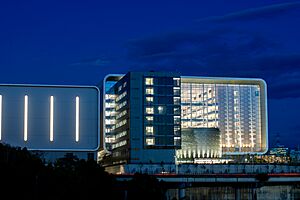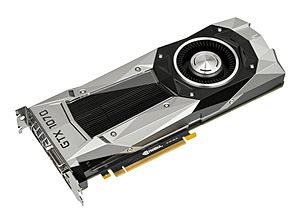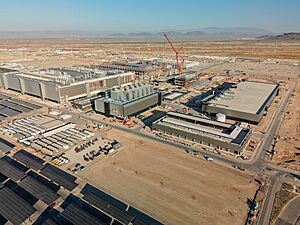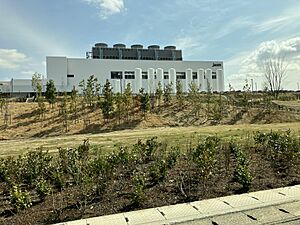TSMC facts for kids
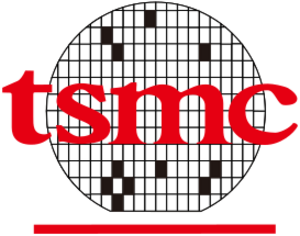 |
|||||||||||||||||
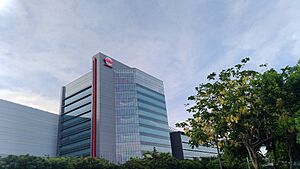
One of TSMC's factories in Taichung's Central Taiwan Science Park
|
|||||||||||||||||
|
Native name
|
台積電
|
||||||||||||||||
|---|---|---|---|---|---|---|---|---|---|---|---|---|---|---|---|---|---|
| Public | |||||||||||||||||
| Traded as | |||||||||||||||||
| ISIN | ISIN: [https://isin.toolforge.org/?language=en&isin=US8740391003 US8740391003] | ||||||||||||||||
| Industry | |||||||||||||||||
| Founded | 21 February 1987, in Industrial Technology Research Institute, Hsinchu, Taiwan | ||||||||||||||||
| Founder | Morris Chang | ||||||||||||||||
| Headquarters |
Hsinchu Science Park
,
Taiwan
|
||||||||||||||||
|
Area served
|
Worldwide | ||||||||||||||||
|
Key people
|
C. C. Wei (president, chairman and CEO) | ||||||||||||||||
|
Production output
|
|||||||||||||||||
| Services |
|
||||||||||||||||
| Revenue | |||||||||||||||||
|
Operating income
|
|||||||||||||||||
| Total assets | |||||||||||||||||
| Total equity | |||||||||||||||||
|
Number of employees
|
73,090 (2024) | ||||||||||||||||
| Divisions | SSMC (38.8% joint venture with NXP) | ||||||||||||||||
| Subsidiaries |
|
||||||||||||||||
| Chinese name | |||||||||||||||||
| Traditional Chinese | 台灣積體電路製造股份有限公司 | ||||||||||||||||
|
|||||||||||||||||
| Abbreviation | |||||||||||||||||
| Traditional Chinese | 台積電 | ||||||||||||||||
|
|||||||||||||||||
Taiwan Semiconductor Manufacturing Company Limited (TSMC) is a huge company from Taiwan. They make tiny electronic parts called semiconductors or chips. These chips are like the brains for almost all electronic devices, from your phone to computers and cars!
TSMC is the biggest company in Taiwan. It is also the world's largest company that only makes chips for other companies. Many famous tech companies, like Apple and Nvidia, rely on TSMC to make their chips. Its main offices and factories are in the Hsinchu Science Park in Taiwan.
Morris Chang started TSMC in 1987. It was the first company ever to focus only on making chips for others. In 2018, Morris Chang retired after leading TSMC for 31 years. Then, Mark Liu became chairman and C. C. Wei became the Chief Executive. TSMC has been listed on the Taiwan Stock Exchange since 1993. In 1997, it became the first Taiwanese company to be listed on the New York Stock Exchange.
Many companies that design chips but don't make them (called "fabless" companies) are customers of TSMC. These include AMD, Apple, Broadcom, MediaTek, and Qualcomm. Even some companies that have their own factories, like Intel, sometimes ask TSMC to make some of their chips.
TSMC can produce about 13 million large chips (300 mm size) each year. They make chips using very advanced technologies, from 2 microns down to 3 nanometres. TSMC was the first company to offer 7-nanometre and 5-nanometre chip production. These technologies are used in devices like the Apple A14 and M1 chips found in Apple products.
Contents
How TSMC Started
In 1986, a government official named Li Kwoh-ting asked Morris Chang to help build Taiwan's chip industry. At that time, it was hard to find investors because making chips needed a lot of money and had high risks.
Only Philips (a Dutch company) agreed to invest $58 million. They also shared their technology and patents with TSMC. In return, Philips got a 27.5 percent share in TSMC. The Taiwanese government also provided a lot of money (48 percent of the starting funds). Other wealthy families in Taiwan were also asked to invest. This shows that TSMC was a big project supported by the Taiwanese government from the very beginning.
TSMC has continued to grow over the years. In 2011, the company planned to spend much more money on research and development. This was to stay ahead of other companies. They also planned to make 30 percent more chips to meet high demand.
In 2014, TSMC started making chips for Apple's iPad and iPhone devices. Apple became a very important customer for TSMC.
Recent Developments
In 2020, TSMC promised to use 100 percent renewable energy by 2050. This is a big deal because TSMC uses about 5 percent of all the energy in Taiwan. This plan is expected to help Taiwan switch to more green energy.
To reduce risks, TSMC has been building new factories in other countries since the early 2020s. They have opened new factories in Japan and the United States. They also plan to expand into Germany.
In July 2020, TSMC stopped shipping chips to Huawei, a Chinese company. This was due to new rules from the United States.
From 2020 to 2023, there was a worldwide shortage of chips. Because of this, TSMC raised the prices for some of its chips.
In November 2021, TSMC and Sony announced a new company called Japan Advanced Semiconductor Manufacturing (JASM) in Japan. This factory makes chips using 22- and 28-nanometer technologies. Construction started in 2022, and production began in 2024.
In February 2022, Denso (a car parts company) also invested in JASM. This helped JASM make even more advanced chips for cars. The Japanese government wants JASM to supply important chips to Japanese electronics and car companies. This factory is expected to create about 1,700 high-tech jobs.
In July 2022, TSMC announced record profits. This was because of strong growth in chips for cars and data centers. In February 2024, TSMC's shares reached a record high. This was partly due to the success of chip designer Nvidia. TSMC currently makes 3-nanometer chips and plans to start making 2-nanometer chips in large amounts in 2025.
In October 2024, TSMC told the United States government about a possible problem. One of its advanced chips might have been sent to Huawei through another company linked to the Chinese government.
In June 2025, TSMC opened its first joint research lab with a university outside Taiwan. It is called the TSMC-UTokyo Lab and is with the University of Tokyo Laboratory.
Patent Dispute with GlobalFoundries
In 2019, another chip company called GlobalFoundries said that TSMC was using some of their patented ideas without permission. They filed lawsuits in the US and Germany. TSMC said these claims were not true.
Later, TSMC also filed lawsuits against GlobalFoundries, saying they were using TSMC's patented ideas. On October 29, 2019, both companies announced they had solved the problem. They agreed to share their existing chip patents and new patents for the next 10 years.
Company Leadership
- Chief Executive: C. C. Wei (since June 2018)
- Chairman: C. C. Wei (since June 2024)
Past Leaders
- Morris Chang was chairman from 1987 to 2018.
- Mark Liu was chairman from 2018 to 2024.
- Other past chief executives include Rick Tsai and Morris Chang (who had a second term).
Business Information
TSMC's business changes with the ups and downs of the semiconductor industry. When demand for chips is high, TSMC needs to make sure it can produce enough. But when demand is low, they have extra factory space. This can affect their financial results.
In 2014, TSMC was a leader in making chips for smartphones. Companies like Qualcomm and Apple placed many orders with them. TSMC's revenue (money earned) grew a lot in 2014, by 28 percent compared to the year before.
Technologies Used
TSMC uses very advanced technology to make chips. One of these is called N7+, which uses extreme ultraviolet lithography. This technology helps make tiny, detailed circuits on the chips. N7+ allows more parts to be packed onto a chip and uses less power.
The N5 technology doubles how many parts can fit on a chip and makes them work 15 percent better. As of June 2020, TSMC was making Apple's 5-nanometer chips for their computers. In July 2020, TSMC made a big deal to buy all the power from two offshore wind farms in Taiwan. This was the largest corporate green energy order ever at that time.
Production Capabilities
TSMC makes chips on large, round pieces of silicon called wafers. They can make chips using many different sizes of technology, called "nodes." These range from 0.13 micrometers (130 nanometers) down to 3 nanometers. Smaller numbers mean more advanced and powerful chips.
Some of their advanced technologies include:
- 28 nanometer (used for high-performance and low-power chips)
- 16 nanometer (called FinFET, a special type of transistor)
- 10 nanometer
- 7 nanometer (used for high-performance computing)
- 6 nanometer (an improved version of 7 nanometer)
- 5 nanometer
- 4 nanometer (an improved version of 5 nanometer)
- 3 nanometer (started making these in late 2022)
TSMC also helps companies design their chips to work best with TSMC's manufacturing process.
Factories Around the World
TSMC has many factories, called "fabs," in different locations.
| Name | Location | Category | Remarks |
|---|---|---|---|
| Fab 2 | Hsinchu (24°46′25″N 120°59′55″E / 24.77361°N 120.99861°E) |
150 mm wafer | |
| Fab 3 | Hsinchu (24°46′31″N 120°59′28″E / 24.77528°N 120.99111°E) |
200 mm wafer | |
| Fab 5 | Hsinchu (24°46′25″N 120°59′55″E / 24.77361°N 120.99861°E) |
200 mm wafer | |
| Fab 6 | Shanhua District (23°06′36.2″N 120°16′24.7″E / 23.110056°N 120.273528°E) |
200 mm wafer | phases 1 & 2 operational |
| Fab 8 | Hsinchu (24°45′44″N 121°01′11″E / 24.76222°N 121.01972°E) |
200 mm wafer | |
| Fab 10 | Songjiang, Shanghai (31°2′7.6″N 121°9′33″E / 31.035444°N 121.15917°E) |
200 mm wafer | TSMC China Company Limited |
| Fab 11 | Camas, Washington (45°37′7.7″N 122°27′20″W / 45.618806°N 122.45556°W) |
200 mm wafer | TSMC Washington (formerly known as WaferTech) |
| Fab 12A | Hsinchu (24°46′24.9″N 121°0′47.2″E / 24.773583°N 121.013111°E) |
300 mm wafer | phases 1, 2, 4–7 operational, phase 8 under construction, and phase 9 planned TSMC head office |
| Fab 12B | Hsinchu (24°46′37″N 120°59′35″E / 24.77694°N 120.99306°E) |
300 mm wafer | TSMC R&D Center, phase 3 operational |
| Fab 14 | Shanhua District (23°06′46.2″N 120°16′26.9″E / 23.112833°N 120.274139°E) |
300 mm wafer | phases 1–7 operational, phase 8 under construction |
| Fab 15 | Taichung (24°12′41.3″N 120°37′2.4″E / 24.211472°N 120.617333°E) |
300 mm wafer | phases 1–7 operational |
| Fab 16 | Nanjing, Jiangsu (31°58′33″N 118°31′59″E / 31.97583°N 118.53306°E) |
300 mm wafer | TSMC Nanjing Company Limited |
| Fab 18 | Anding District, Tainan (23°07′05″N 120°15′45″E / 23.11806°N 120.26250°E) |
300 mm wafer | phases 1–8 operational |
| Fab 20 | Hsinchu (24°45′51″N 121°0′10″E / 24.76417°N 121.00278°E) |
300 mm wafer | planned in 4 phases |
| Fab 21 | Phoenix, Arizona (33°46′30″N 112°09′30″W / 33.77500°N 112.15833°W) |
300 mm wafer | phase 1 under construction, opening projected for the end of 2024; phase 2 under construction, opening projected for the end of 2026 |
| Fab 22 | Kaohsiung (22°42′35″N 120°18′44″E / 22.70972°N 120.31222°E) |
300 mm wafer | phases 1 operational, phase 2 under construction and phase 3-5 planned |
| JASM (Fab 23) | Kikuyo, Kumamoto, Japan (32°53′8″N 130°50′33″E / 32.88556°N 130.84250°E) |
300 mm wafer | Japan Advanced Semiconductor Manufacturing, Inc.
joint venture founded by TSMC (70%), Sony Semiconductors Solutions (20%), and Denso (10%) |
| SSMC | Singapore (1°22′58″N 103°56′5.7″E / 1.38278°N 103.934917°E) |
200 mm wafer | Systems on Silicon Manufacturing Cooperation, 1998 founded as joint venture by TSMC, Philips Semiconductors (now NXP Semiconductors), and EDB Investments, Singapore. In November 2006 EDB left the joint venture and TSMC raised their stake in SSMC to 38.8%, NXP to 61.2%. |
| Advanced Backend Fab 1 | Hsinchu (24°46′39.6″N 120°59′28.9″E / 24.777667°N 120.991361°E) |
Backend | |
| Advanced Backend Fab 2 | Shanhua District (23°06′46.2″N 120°16′26.9″E / 23.112833°N 120.274139°E) |
Backend | AP2B and AP2C operational |
| Advanced Backend Fab 3 | Longtan District, Taoyuan (24°53′01″N 121°11′11″E / 24.883541°N 121.186478°E) |
Backend | |
| Advanced Backend Fa 5 | Taichung (24°12′52.9″N 120°37′05.1″E / 24.214694°N 120.618083°E) |
Backend | |
| Advanced Backend Fab 6 | Zhunan (24°42′25″N 120°54′26″E / 24.70694°N 120.90722°E) |
Backend | planned in 3 phases, AP6A operational, phases B & C under construction |
| Advanced Backend Fab 7 | Taibo City, Chiayi County (23°28′27.1″N 120°18′05.9″E / 23.474194°N 120.301639°E) |
Backend | planned in 2 phases |
Factories in Arizona, USA
In 2020, TSMC announced plans to build a factory in Phoenix, Arizona in the United States. This factory, called Fab 21, was expected to start making chips by the end of 2024. It was a big step for TSMC to bring its newest 5-nanometer technology to the US.
TSMC planned to spend $12 billion on this project over eight years. The company said the plant would create 1,900 full-time jobs. In December 2022, TSMC announced it would triple its investment in the Arizona plants. This was due to growing tensions between the US and China and problems with the global supply chain.
However, building in the US was more expensive than in Taiwan. It also took time to find enough skilled workers. TSMC brought Taiwanese workers to the US to help train American employees. In July 2023, TSMC said the factory would not be fully ready until 2025.
In April 2024, the US government agreed to provide $6.6 billion in funding and up to $5 billion in loans to TSMC for these factories. This support is part of the CHIPS and Science Act. It aims to boost chip production in the US.
Halo Vista Development
In October 2024, it was announced that the area around the TSMC plants in Arizona would be developed into a community called Halo Vista. This area will include restaurants, hotels, and housing. There will also be a research and technology park to help support the chip industry. Up to six factories could be built there in total.
Factories in Washington, USA
TSMC Washington is another TSMC factory in Camas, Washington, near Portland, Oregon. This factory started in 1996 as a joint project with other companies. TSMC bought out the other partners in 2000, making it a fully owned TSMC factory.
As of 2024, this factory employs 1,100 workers. It makes chips using older technologies, from 0.35 to 0.16 micrometers.
Factories in Japan
In November 2021, TSMC and Sony announced a new company called Japan Advanced Semiconductor Manufacturing (JASM) in Kumamoto, Japan. Denso and Toyota have also invested in this company.
The first factory (Fab 23) in Kikuyo, Kumamoto, started making chips in December 2024. It produces 12-, 22-, and 28-nanometer chips. The Japanese government helped fund this factory. A second factory is being built next to the first one. It will make more advanced 6-nanometer and 12-nanometer chips.
Factories in Germany
In August 2023, TSMC committed to building a factory in Dresden, Germany. This factory is a joint project with three European companies: Robert Bosch GmbH, Infineon Technologies, and NXP Semiconductors. The new company is called European Semiconductor Manufacturing Company (ESMC). The German government is also providing a lot of money to support this factory. It is planned to be fully working by 2029.
See also
 In Spanish: TSMC para niños
In Spanish: TSMC para niños
- List of companies of Taiwan
- List of semiconductor fabrication plants
- Moore's law
- Semiconductor industry in Taiwan


